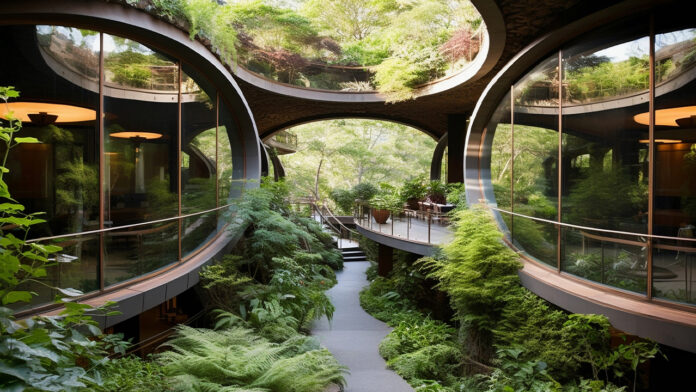In a world increasingly dominated by urban landscapes, Biophilic Design emerges as a transformative approach that seeks to bring nature back into our daily lives. This design philosophy goes beyond aesthetics, aiming to enhance well-being, foster productivity, and promote sustainability in the built environment. In this article, we delve into the captivating facts about Biophilic Design, exploring its principles, benefits, and the innovative ways architects and designers bring the essence of nature into our living and working spaces.
Understanding Biophilic Design
Definition and Philosophy: Biophilic Design is rooted in the idea that humans have an innate connection with nature. This design philosophy integrates natural elements, materials, and processes into the built environment to create spaces that enhance our physical and mental well-being.
Biophilia in Architecture: The term “biophilia,” coined by biologist E.O. Wilson, refers to the inherent human affinity for nature. Biophilic Design in architecture acknowledges and incorporates this connection, promoting environments that mimic natural settings.
Core Principles of Biophilic Design
Nature in the Space: Integrating natural elements such as plants, water features, and natural materials directly into architectural spaces is a key principle. This brings the beauty and tranquility of nature indoors.
Natural Light and Views: Maximizing exposure to natural light and providing views of outdoor landscapes are fundamental. Access to daylight not only reduces reliance on artificial lighting but also positively influences circadian rhythms.
Health and Well-Being Benefits
Stress Reduction: Biophilic Design has been shown to reduce stress levels. Exposure to nature-inspired elements, greenery, and natural light contributes to a sense of calmness and relaxation.
Enhanced Cognitive Function: Studies indicate that incorporating Biophilic elements in the workplace can lead to improved cognitive function. Greenery and natural views have been linked to increased creativity, focus, and problem-solving abilities.
Sustainable Interiors and Green Building
Energy Efficiency: Biophilic Design often aligns with green building practices. Incorporating natural light reduces the need for artificial lighting, contributing to energy efficiency in buildings.
Indoor Air Quality: The inclusion of indoor plants in Biophilic Design not only adds aesthetic value but also improves indoor air quality. Certain plants act as natural air purifiers, enhancing the overall health of occupants.
Nature-Inspired Architectural Elements
Biomorphic Shapes and Patterns: Biophilic Design embraces organic shapes and patterns that mimic elements found in nature. From curved lines reminiscent of flowing water to fractal patterns found in leaves, these elements evoke a sense of natural harmony.
Green Walls and Vertical Gardens: Vertical gardens and green walls introduce living vegetation into interior spaces. This not only adds visual interest but also contributes to improved air quality and a sense of connection with the outdoors.
Biophilic Design in Different Environments
Residential Spaces: In homes, Biophilic Design can be incorporated through the use of natural materials, large windows with views of nature, and private outdoor spaces that blend seamlessly with the interior.
Workplace Environments: Biophilic elements in the workplace, such as communal green spaces, indoor plants, and natural light, can enhance employee well-being, productivity, and job satisfaction.
Biophilic Design Case Studies
Amazon Spheres, Seattle: The Amazon Spheres are iconic glass domes filled with plant life, creating a lush indoor environment for employees. This innovative workspace showcases the integration of nature in a corporate setting.
One Central Park, Sydney: One Central Park features vertical gardens designed by Patrick Blanc. These gardens, along with other Biophilic elements, transform the residential and commercial complex into a green oasis in the heart of the city.
The Role of Environmental Psychology
Human-Nature Connection: Environmental psychology studies highlight the positive impact of nature on human psychology. Biophilic Design leverages these findings to create environments that support mental well-being.
Restorative Environments: Exposure to natural elements has been associated with restorative effects. Biophilic spaces provide individuals with opportunities for restoration and stress recovery.
Future Trends and Innovations
Smart Biophilic Design: The integration of technology with Biophilic Design is a growing trend. Smart systems can regulate lighting, temperature, and humidity to mimic natural conditions, enhancing the overall Biophilic experience.
Urban Biophilia: As urbanization continues, there is a growing emphasis on Urban Biophilia—introducing green spaces, vertical gardens, and nature-inspired designs into the fabric of urban environments to improve overall livability.
Conclusion: Inviting Nature Back into Our Lives
In conclusion, Biophilic Design stands as a profound testament to the power of nature in shaping our well-being and the environments we inhabit. As architects, designers, and urban planners embrace these principles, our homes, workplaces, and public spaces are transformed into havens that reconnect us with the natural world. The journey towards a harmonious coexistence with nature through Biophilic Design is not just a trend; it’s a fundamental shift towards creating sustainable, healthy, and inspiring spaces that enrich our lives.

